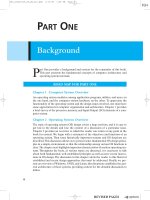Operating system internal and design principles by williams stallings chapter 014
Bạn đang xem bản rút gọn của tài liệu. Xem và tải ngay bản đầy đủ của tài liệu tại đây (474.93 KB, 71 trang )
Security
Chapter 15
1
2
Types of Threats
• Interruption
– An asset of the system is destroyed of becomes unavailable
or unusable
– Attack on availability
– Destruction of hardware
– Cutting of a communication line
– Disabling the file management system
3
Types of Threats
• Interception
– An unauthorized party gains access to an asset
– Attack on confidentiality
– Wiretapping to capture data in a network
– Illicit copying of files or programs
4
Types of Threats
• Modification
– An unauthorized party not only gains access but tampers with
an asset
– Attack on integrity
– Changing values in a data file
– Altering a program so that it performs differently
– Modifying the content of messages being transmitted in a
network
5
Types of Threats
• Fabrication
– An unauthorized party inserts counterfeit objects into the
system
– Attack on authenticity
– Insertion of spurious messages in a network
– Addition of records to a file
6
Computer System Assets
• Hardware
– Threats include accidental and deliberate damage
• Software
– Threats include deletion, alteration, damage
– Backups of the most recent versions can maintain high
availability
7
Computer System Assets
• Data
– Involves files
– Security concerns fro availability, secrecy, and integrity
– Statistical analysis can lead to determination of individual
information which threatens privacy
8
Computer System Assets
• Communication Lines and Networks – Passive
Attacks
– Learn or make use of information from the system but does
not affect system resources
– Traffic analysis
• Encryption masks the contents of what is
transferred so even if obtained by someone,
they would be unable to extract information
9
Computer System Assets
• Communication Lines and Networks – Passive
Attacks
– Release of message contents for a telephone
conversion, an electronic mail message, and a
transferred file are subject to these threats
10
Computer System Assets
• Communication Lines and Networks – Passive
Attacks
– Traffic analysis
• Encryption masks the contents of what is transferred so
even if obtained by someone, they would be unable to
extract information
11
Computer System Assets
• Communication Lines and Networks – Active
Attacks
– Masquerade takes place when one entity pretends
to be a different entity
12
Computer System Assets
• Communication Lines and Networks – Active
Attacks
– Replay involves the passive capture of a data unit
and its subsequent retransmission to produce an
unauthorized effect
13
Computer System Assets
• Communication Lines and Networks – Active Attack
– Modification of messages means that some portion of a
legitimate message is altered, or that messages are delayed
or reordered, to produce an unauthorized effect
14
Computer System Assets
• Communication Lines and Networks – Active
Attacks
– Denial of service prevents or inhibits the normal
use or management of communications facilities
• Disable network or overload it with messages
15
Protection
• No protection
– Sensitive procedures are run at separate times
• Isolation
– Each process operates separately from other processes with
no sharing or communication
16
Protection
• Share all or share nothing
– Owner of an object declares it public or private
• Share via access limitation
– Operating system checks the permissibility of each access by
a specific user to a specific object
– Operating system acts as the guard
17
Protection
• Share via dynamic capabilities
– Dynamic creation of sharing rights for objects
• Limit use of an object
– Limit not just access to an object but also the use to which
that object may be put
– Example: a user may be able to derive statistical summaries
but not to determine specific data values
18
Protection of Memory
• Security
• Correct functioning of the various processes that are
active
19
User-Oriented Access Control
• Referred as authentication
• Log on
– Requires both a user identifier (ID) and a password
– System only allows users to log on if the ID is
known to the system and password associated with
the ID is correct
– Users can reveal their password to others either
intentionally or accidentally
– Hackers are skillful at guessing passwords
– ID/password file can be obtained
20
Data-Oriented Access Control
• Associated with each user, there can be a profile that
specifies permissible operations and file accesses
• Operating system enforces these rules
• Database management system controls access to
specific records or portions of records
21
Access Matrix
• Subject
– An entity capable of accessing objects
• Object
– Anything to which access is controlled
• Access rights
– The way in which an object is accessed by a subject
22
Access Matrix
23
Access Control List
• Matrix decomposed by columns
• For each object, an access control list gives users and
their permitted access rights
24
Access Control List
25









